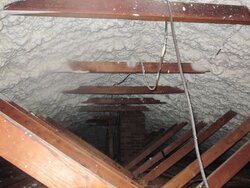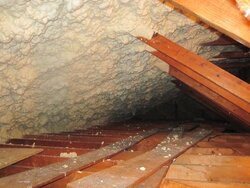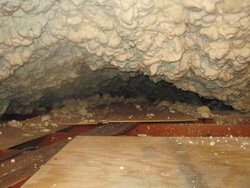Hopefully this helps with the bills. AC/Electric killed us in summer and the house was still hot. NG killed us in the winter and the house was freezing cold. Also had severe ice dam problems.
Spray foamed the attic
- Thread starter kingquad
- Start date
-
Active since 1995, Hearth.com is THE place on the internet for free information and advice about wood stoves, pellet stoves and other energy saving equipment.
We strive to provide opinions, articles, discussions and history related to Hearth Products and in a more general sense, energy issues.
We promote the EFFICIENT, RESPONSIBLE, CLEAN and SAFE use of all fuels, whether renewable or fossil.
You are using an out of date browser. It may not display this or other websites correctly.
You should upgrade or use an alternative browser.
You should upgrade or use an alternative browser.
- Status
- Not open for further replies.
I'm wondering how this space is going to ventilate. Why was the roof underside foamed and not the joist spaces?
fishingpol
Minister of Fire
Hmmm, I have not seen an application like that before. I hope there are propa-vents in between the rafters. Tell us more of how it was applied and prep work involved.
btuser
Minister of Fire
You won't need to ventilate. Its the difference in temperature that is harmfull to shingles not the heat. An installation like that should actually close up the soffits.
velvetfoot
Minister of Fire
laynes69
Minister of Fire
The only time I have seen hot roofs was on modern homes. I also wonder why the roof was sprayed instead of floor. Did they spray with open or closed cell?
smokinj
Minister of Fire
This is how my craw space is done. I do vent it a little in the summer but not much. Thats a lot of foam there!
btuser
Minister of Fire
stejus
Minister of Fire
I don't get it. If an attic can't breath, doesn't that create moisture? I can see how the heat or cold will not penetrate through the insulation, but there has to be some sort of heat buildup and cooling which if not vented, will create condensation, eh?
I read some articles which suggested this for hot climates like Arizona, but they really only covered summer heat and not the risk of condensation in the winter. I will be curious to see how this works out. It would be great to have a remote thermometer up there to see what the winter temps are in the attic. If they are close to the house temps, then perhaps condensation is not an issue as long as home moisture from showers doesn't get in the space. It certainly should reduce the ice dams. Please keep us posted on how this works out.
http://www.sprayfoam.com/spps/ahpg.cfm?spgid=66
http://www.sprayfoam.com/spps/ahpg.cfm?spgid=66
laynes69
Minister of Fire
The way I have always taken it is once you create a hot roof like that, that area must be treated as conditioned living space. Also if there ever was a leak in the roofing, the deck could rot out going unknown. I know it's still a fairly new concept so like everyone else I'm curious.
velvetfoot
Minister of Fire
These guys seem to be thinking along those lines with this recent article.
http://www.buildingscience.com/docu...les/etw-ngrid-millbury-cape-building-profile/
http://www.buildingscience.com/docu...les/etw-ngrid-millbury-cape-building-profile/
I'm going to run a small feed and return from our HVAC to cycle some fresh air in. Estimator discussed insulating the rafters(spraying up) and the joist spaces(spraying down). I choose to spray down. The installer showed up and told me there was no possible way to spray down and ventilate and be able to fully cover the top plate on the edges of the walls due to my very shallow pitched roof. The previous owner had dense packed blow in down into the eaves/soffit vents to insulate, so I had no ventilation previously. Hope my explanation is clear.BeGreen said:I'm wondering how this space is going to ventilate. Why was the roof underside foamed and not the joist spaces?
They came in and started removing the insulation between the joists in order to spray down. The installer basically told me there was no way to guarantee that I'd be able to seal my top plate plus get a decent amount of foam on top of it while still having the space to ventilate. I have a very shallow pitched roof. My rafters are 2x4(actual size) w/24in OC. Spraying up was the only way to guarantee that the "building envelope" would be completely sealed.fishingpol said:Hmmm, I have not seen an application like that before. I hope there are propa-vents in between the rafters. Tell us more of how it was applied and prep work involved.
Icynene open cell foam. Rafters are 2x4 24inOC. Terra cotta roof. Was advised that closed cell could be too much weight on the rafters.laynes69 said:The only time I have seen hot roofs was on modern homes. I also wonder why the roof was sprayed instead of floor. Did they spray with open or closed cell?
Was advised by the company(they do this type of install all the time) that the attic is now considered a "conditioned space" The estimator and installer both said that attic temps in this setup are typically about 10 degrees warmer than the living space. I plan on doing a detailed post at the end of winter to compare our bills to last winter. Ice Dams were also a huge problem previously. So bad that the ice would crack tiles on our patio. Patio has been completely replaced with standing seam copper cause we got sick of fixing tiles every spring and we also developed a leak this spring.BeGreen said:I read some articles which suggested this for hot climates like Arizona, but they really only covered summer heat and not the risk of condensation in the winter. I will be curious to see how this works out. It would be great to have a remote thermometer up there to see what the winter temps are in the attic. If they are close to the house temps, then perhaps condensation is not an issue as long as home moisture from showers doesn't get in the space. It certainly should reduce the ice dams. Please keep us posted on how this works out.
http://www.sprayfoam.com/spps/ahpg.cfm?spgid=66
btuser
Minister of Fire
If you use the foam to build differently you can cut down on the costs of it. After a certain thickness you don't need to invest in vapor barrier or ventilation. The only thing I've heard that may be a problem with open-cell foam installed like this is it can absorb water. So if you get a leak not only is it very difficult to find it but a massive amount of weight can build up.
What was the square footage/thickness/r-value (and of course, cost) of the install?
What was the square footage/thickness/r-value (and of course, cost) of the install?
Original sqft on spray down install was about 1300. At 6in thickness this cost about $3500 dollars. Not cheap. This would be an r-24. Spray the rafters increased the sqft. by a lot. Because the estimator didn't pick up and advise me on the inability to spray down, the insulation company picked up the initial cost. Kudos to them. Not too many businesses like that out there anymore.
I'm aware of some of the stated risks and will be watching it closely. My former roof problems were all caused by ice dams. I don't think that will be a problem anymore. If it did take on water, I think the wet section would deteriorate very quickly and fall out. It seems pretty delicate.
I'm aware of some of the stated risks and will be watching it closely. My former roof problems were all caused by ice dams. I don't think that will be a problem anymore. If it did take on water, I think the wet section would deteriorate very quickly and fall out. It seems pretty delicate.
Highbeam
Minister of Fire
This seems like a good application. You've got such thick foam because it's open cell (lower r-value per inch) and because it's not going to be used as a living space or frequently accessed area. Open cell allows the roofing materials to dry both out and inwards.
The comment on weight doesn't make a whole lot of sense to me. Open cell weighs about 1/4th of closed cell, but you make it alot thicker too to get the r-value - so it's not THAT much lighter. And we're talking a difference of ~1 pound per square foot on the roof itself. That's practically nothing IMHO - although maybe with your pitch + construction + terra cotta + snow possibilities it's worth the precaution.
...
Also, interesting to see a terra cotta roof in PA. I love terra cotta. I love it's sturdiness, it's look, and it's simplicity.
The comment on weight doesn't make a whole lot of sense to me. Open cell weighs about 1/4th of closed cell, but you make it alot thicker too to get the r-value - so it's not THAT much lighter. And we're talking a difference of ~1 pound per square foot on the roof itself. That's practically nothing IMHO - although maybe with your pitch + construction + terra cotta + snow possibilities it's worth the precaution.
...
Also, interesting to see a terra cotta roof in PA. I love terra cotta. I love it's sturdiness, it's look, and it's simplicity.
Yeah, I thought so too. Funny thing is that every house on the street has it. The houses on my street and in parts of my neighborhood were developed by Heinz for their employees. They are almost all ranches with similar floorplans and similar design features. Many of my neighbors will be watching my house closely this winter. The low pitch/terra cotta/heavy snow situation means everyone has really bad ice dams. All of my neighbors know about my insulation install and will be looking for feedback after winter.joefrompa said:This seems like a good application. You've got such thick foam because it's open cell (lower r-value per inch) and because it's not going to be used as a living space or frequently accessed area. Open cell allows the roofing materials to dry both out and inwards.
The comment on weight doesn't make a whole lot of sense to me. Open cell weighs about 1/4th of closed cell, but you make it alot thicker too to get the r-value - so it's not THAT much lighter. And we're talking a difference of ~1 pound per square foot on the roof itself. That's practically nothing IMHO - although maybe with your pitch + construction + terra cotta + snow possibilities it's worth the precaution.
...
Also, interesting to see a terra cotta roof in PA. I love terra cotta. I love it's sturdiness, it's look, and it's simplicity.
Initial report is that the house holds temperatures much better now. The temps used to swing very quickly with the outside temps. Haven't needed to use the AC or heat yet. We're holding heat better at night and staying cooler during the day.
Yes and Yes. It's pretty crazy looking up there.Highbeam said:So they sprayed the gable ends too then? Looks like a big upside down coleman cooler eh?
- Status
- Not open for further replies.
Similar threads
- Replies
- 5
- Views
- 420
- Replies
- 36
- Views
- 2K
- Replies
- 4
- Views
- 2K




